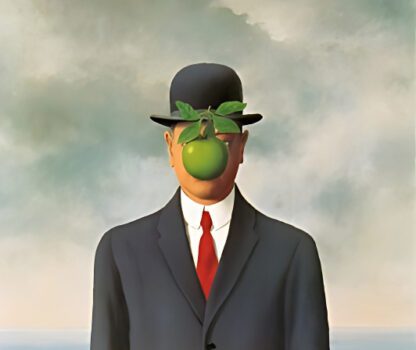What is the meaning behind the painting Son of Man
René Magritte’s The Son of Man is one of the most recognizable paintings in the world. The painting, depicting a man in a suit and bowler hat with a green apple obscuring his face, has been widely interpreted in various ways, making it a cornerstone of surrealist art. Painted in 1964, this surrealist masterpiece continues to intrigue audiences with its enigmatic imagery, thought-provoking symbolism, and deep philosophical undertones. But what exactly is the meaning behind The Son of Man? Why is it so famous? And what significance does the apple hold in the painting? Let’s explore these questions in depth.
The Meaning Behind The Son of Man
Magritte himself described The Son of Man as a self-portrait, but it is far from a traditional representation of an artist. The painting features a man standing against a cloudy sky and a sea-like background, dressed formally in a black overcoat, red tie, and bowler hat. The most striking element of the painting is the green apple that floats directly in front of the man’s face, obscuring his identity.
The painting exemplifies Magritte’s fascination with hidden meanings and the tension between what is visible and what is concealed. The apple acts as an obstruction, preventing the viewer from seeing the subject’s full face. Magritte once said, “Everything we see hides another thing, we always want to see what is hidden by what we see.” This idea encapsulates the central theme of the painting: the mystery of human identity and the limits of perception.
More over almost a whimsical scene: a man in a dark suit and bowler hat, standing against a cloudy sky, with an apple perfectly positioned to conceal his face. Yet, beneath this apparent simplicity lies a complex meditation on identity, perception, and the tension between what is revealed and what is hidden. Magritte said that that everything in his work is “visible, yet hidden,” a paradox that The Son of Man embodies fully. By choosing to obscure his own visage, Magritte forces viewers to confront the limitations of surface appearances and question the reliability of first impressions.
The apple covering the face serves multiple symbolic and conceptual purposes. On one level, it disrupts the traditional notion of a self-portrait as a straightforward representation of the artist. In conventional portraiture, the face is central to identity, conveying emotion, personality, and inner life. By hiding his face, Magritte undermines this expectation, suggesting that the essence of a person cannot be fully captured through physical likeness alone. The apple, ordinary yet rendered uncanny by its placement, transforms an everyday object into a powerful visual metaphor for concealment and mystery. It reflects Magritte’s broader interest in the surrealist fascination with the unexpected juxtaposition of ordinary objects, compelling viewers to reconsider what they think they know about reality.
Beyond its artistic experimentation, The Son of Man continues to spark debates about individuality and the ways people choose to present, or obscure, themselves. In an era obsessed with visibility, self-expression, and social media, the image resonates in a modern context, raising questions about the masks we wear in daily life. Magritte’s covered face becomes a universal symbol of the tension between private and public identity, highlighting how much of ourselves remains hidden, even when we believe we are fully seen. It reminds us that every individual is a combination of revealed traits and concealed complexities, and that attempts to fully understand another person are inevitably limited by what remains unseen.
Moreover, the painting engages viewers in an ongoing dialogue about perception and interpretation. The apple both conceals and attracts attention, emphasizing the interplay between presence and absence, seen and unseen. This duality invites reflection on the act of looking itself, asking observers to consider not only what they see but also how their expectations and assumptions shape that vision. Magritte’s work challenges the notion of a singular truth, suggesting instead that reality is layered, elusive, and perpetually open to reinterpretation.
Magritte’s choice to paint himself with his face hidden behind an apple is a masterful exploration of concealment, identity, and the limits of perception. The Son of Man continues to captivate audiences precisely because it is both familiar and mysterious, playful and profound. It encourages us to reflect on our own identities, the masks we wear, and the hidden truths that shape our understanding of others. By transforming an ordinary object into a symbol of the unseen, Magritte reminds us that reality is never fully transparent, and that the search for meaning often lies as much in what is hidden as in what is visible.
The Son of Man challenges the viewer to question reality, identity, and the way we perceive the world around us. It suggests that even when we think we understand something or someone, there is always something hidden from our view, something just beyond our grasp.
Why Is The Son of Man So Famous?
There are several reasons why The Son of Man has achieved such widespread fame:
1. Surrealist Mystery and Symbolism
Surrealism as an art movement sought to challenge conventional perceptions of reality. Magritte, one of the movement’s most celebrated artists, excelled at creating seemingly ordinary scenes with strange, unsettling elements. The hidden face in The Son of Man is a perfect example of this surrealist approach, an ordinary businessman with an extraordinary obstruction that invites endless interpretation.
2. Cultural Influence and Popularity
The painting has been referenced in countless films, TV shows, books, and advertisements. It has been parodied, reinterpreted, and even used in political commentary. Its striking imagery makes it instantly recognizable and often associated with themes of anonymity, secrecy, and the hidden aspects of human nature.
3. Universality of the Subject
The faceless man in a bowler hat is a common motif in Magritte’s works, representing the “everyman.” The anonymity of the figure allows viewers to project their own interpretations onto the painting, making it deeply personal yet universally relatable. The theme of hidden identity resonates across cultures and generations, contributing to its lasting appeal.
4. Philosophical Depth
The painting is often discussed in philosophical circles due to its commentary on perception and reality. The idea that people hide parts of themselves, whether intentionally or not, aligns with existentialist and psychoanalytic thought, further solidifying its intellectual appeal.
The Meaning of the Apple in The Son of Man
The green apple in The Son of Man is perhaps its most iconic element, and it carries multiple layers of meaning.
1. Biblical Symbolism
One of the most common interpretations of the apple is its connection to the biblical story of Adam and Eve. In the Book of Genesis, the apple represents forbidden knowledge and temptation. By placing the apple in front of the man’s face, Magritte could be alluding to the idea that knowledge, or the truth, is obscured from us.
2. Magritte’s Playful Irony
Magritte often used everyday objects in unexpected ways to challenge viewers’ assumptions. He may have deliberately chosen an apple, an ordinary and familiar fruit, to create a sense of irony. Rather than revealing something profound, the apple acts as an obstruction, reinforcing the idea that reality is always partially hidden.
3. Anonymity and Concealment
The apple covering the man’s face serves as a literal barrier to identity. This suggests themes of anonymity and concealment, making the viewer wonder about the true identity of the subject and what lies beneath the surface. This aligns with Magritte’s broader themes of deception, disguise, and the mysteries of human existence.
4. Personal Significance to Magritte
Magritte had a deep appreciation for apples, often featuring them in his works. They appear in several of his other paintings, such as The Listening Room (1952), where a massive green apple fills an entire room, reinforcing the surreal and dreamlike quality of his art.
Where Is The Son of Man Painting Now?
Unlike many famous paintings that reside in major museums, The Son of Man is privately owned and not on permanent public display. The painting remains in a private collection, which has added to its mystique and desirability. However, it has been exhibited in various art museums during special exhibitions, allowing audiences to experience its enigmatic presence in person.
Despite its physical inaccessibility, the painting’s influence permeates contemporary culture through reproductions, digital media, and reinterpretations, ensuring that its impact continues to be felt across the world.
René Magritte’s The Son of Man remains an enduring enigma in the world of art. With its surrealist ambiguity, philosophical depth, and striking imagery, it invites endless interpretation and fascination. The painting challenges our perceptions, encourages us to question what we see, and reminds us that reality is often more complex than it appears. The obscured face, the ordinary-yet-extraordinary apple, and the ever-present sense of mystery make The Son of Man a timeless and thought-provoking masterpiece.




